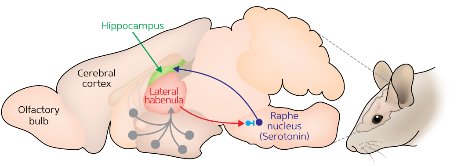Jul. 26, 2013 Research Highlight Biology
The rhythm of sleep
Measurement of brain activity reveals a sleep regulation mechanism that could be disturbed in depression
 Figure 1: The lateral habenula (red) maintains rhythmic theta activity in the hippocampus (green) during REM sleep by modulating serotonergic activity (blue). © 2013 Hidenori Aizawa, RIKEN Brain Science Institute
Figure 1: The lateral habenula (red) maintains rhythmic theta activity in the hippocampus (green) during REM sleep by modulating serotonergic activity (blue). © 2013 Hidenori Aizawa, RIKEN Brain Science Institute
When sleeping, the brain cycles through various stages of sleep characterized by different neural activity. The way in which these stages are regulated, however, remains poorly understood. Hitoshi Okamoto and Hidenori Aizawa from the RIKEN Brain Science Institute have led research that has revealed a previously unknown mechanism of sleep regulation, which may provide insight into the disruption of sleep associated with disorders such as depression1.
Okamoto and his colleagues studied the rapid eye movement (REM) stage of sleep. REM sleep is usually associated with dreaming and is characterized by what is known as theta activity in the hippocampus region of the brain. “Theta activity is a rhythm of neural activity that shows oscillation, with four to ten cycles per second,” explains Aizawa. “This specific rhythm appears when animals are in REM sleep.”
REM sleep is abnormal in patients with depression; it starts sooner than normal after going to sleep and eye movement is more rapid. However, the biological basis for this has been unclear. Previous studies indicated the involvement of the brain chemical serotonin, the metabolism of which is also abnormal in patients with depression. A region of the brain called the lateral habenula (LHb) has also been implicated. The LHb is connected to the raphe nuclei where serotonin is produced and shows higher than normal activity in patients with depression.
To determine the exact role of the LHb in REM sleep, the researchers measured brain activity in sleeping rats. They discovered that when the LHb was damaged, theta activity in the hippocampus—and therefore REM sleep—lasted for a shorter period of time. For this effect to be seen though, the serotonin-producing raphe nuclei had to be intact. The team concluded that the LHb maintains theta activity in the hippocampus during REM sleep and that this effect is mediated by serotonin (Fig. 1).
“This reveals a novel role of the LHb in linking serotonin with REM sleep,” explains Aizawa. “It suggests that a hyperactive habenula in patients with depression causes altered REM sleep.”
Although these findings go some way to explaining the disrupted sleep in depression, Okamoto says that there is more to be done to confirm the link. “Now we’ve shown that inhibition of lateral habenular activity leads to shortening of REM sleep, the next step is to check whether animals with a hyperactive LHb show depressive behaviors and sleep disturbance.”
References
- 1. Aizawa, H., Yanagihara, S., Kobayashi, M., Niisato, K., Takekawa, T., Harukuni, R., McHugh, T. J., Fukai, T., Isomura, Y. & Okamoto, H. The synchronous activity of lateral habenular neurons is essential for regulating hippocampal theta oscillation. The Journal of Neuroscience 33, 8909–8921 (2013). doi: 10.1523/JNEUROSCI.4369-12.2013
